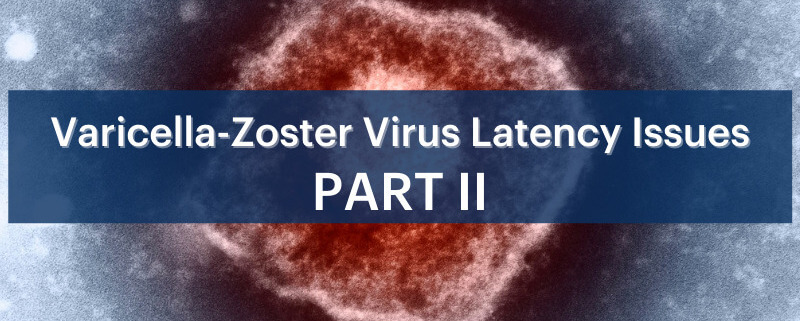INTRODUCTION: Reactivation of varicella-zoster virus (VZV) after a primary infection (chickenpox) leads to herpes zoster (HZ-shingles). In Part I, we discussed a review by Kennedy et al1., which looked at some recent issues in Alphaherpesvirus latency, particularly in regards to VZV ganglionic latency. In Part II, we will look at the immunological aspects of Alphaherpesviruses in regards to VZV latency.
DISCUSSION: The use of “humanized” mouse models along with the study of human inborn errors of immunity, which results in increased susceptibility to VZV, has been of great value. The authors stated that a clear prominent role is played by cellular immunity conferred by T cells and natural killer (NK) cells. The role of humoral immunity remains less clear as a VZV infection and reactivation does not seem to be a major problem in individuals with antibody deficiencies. Previous clinical studies from the VZV pre-vaccine era did show a significant role on VZV immunoglobulins (VZIG) when given to children at risk of severe VZV infection. VZIG was prepared from donors with recent zoster and high levels of VZV specific immunoglobulins, and a small clinical study demonstrated that VZIG administration in immunosuppressed children modified rather than prevented VZV infection. This resulted in decreased morbidity of chickenpox children with leukemia. As a consequence of those findings, VZIG was widely used to protect children with cancer after exposure to varicella in the United States and Europe, from 1975-1995. Of importance, it was shown that all types of interferons (IFNs) show antiviral activity against VZV and serve essential functions in restricting VZV replication and spread, especially during the viremic phase and in the skin during varicella. IFNs were also thought to be involved in maintaining latency in sensory neuronal ganglia. Some studies suggested a greater antiviral role of Type II IFNs (IFNγ) over Type I IFNs (IFNα/β) against VZV in-vitro, while observations from patients with VZV CNS infection, pneumonitis or disseminated skin eruption/zoster in context of defective Type I or Type II IFN pathways, provided more indirect evidence of important non-redundant roles of both Type I and Type II IFNs in protecting against VZV reactivation. Despite several studies addressing these issues, the precise immune cells and immune mediators required for protective immunity in primary infection versus reactivation have not been clarified. In particular, the individual contribution from different cells types, including lymphocytes, macrophages, plasmacytoid dendritic cells and epithelial/endothelial cells, which are all present in human ganglia remains insufficiently understood and explored. In terms of the immune histological examination of ganglia from paraffin-embedded sections of ganglia obtained post-mortem from a patient with post-herpetic neuralgia years after the herpes zoster rash, revealed the presence of VZV DNA, as well as an immunological cell infiltrate composed of CD4 T cells, CD8 T cells and CD20 B cells, which provides evidence of an ongoing immunological reaction and inflammation years after the reactivation of VZV from latency, Sutherland et al2.
CONCLUSION: These studies, and others, lend support to the notion that some degree of chronic low-grade reactivation of Alphaherpesviruses from latency, as well as immune reactions to this event does take place over time in ganglia latently infected with VZV.
REFERENCES:
- Kennedy, P.G.E., T.H. Mogensen, and R.J. Cohrs. (2021). Recent Issues in Varicella-Zoster Virus Latency. Viruses 13, 2018. https://doi.org/10.3390/v13102018
- Sutherland, J.P., M. Steain, M.E. Buckland, M. Rodriguez, A.L. Cunningham, B. Slobedman, and A. Abendroth. (2019) Persistence of a T Cell Infiltrate in Human Ganglia Years After Herpes Zoster and During Post-herpetic Neuralgia. Front. Microbiol. Volume 10, Article 2017. https://doi.org/10.3389/fmicb.2019.02117
MKTG 1067 - Rev A 021522



